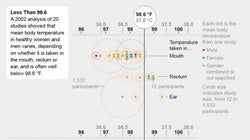 |
| January 17, 2020 |
Dear Reader,
We're getting cooler. A new study argues that 98.6 degrees Fahrenheit, generally accepted as the normal human body temperature, is antiquated. So, do researchers have a more accurate number? And what does the change mean for determining whether or not you have a fever? Today's lead story explains what you need to know. Our body temperature may have dropped, but we know the planet is still warming. Climate change is altering ocean conditions around the world, threatening marine habitats and species. A group of experts make the case for a dynamic approach to conservation: movable marine sanctuaries. And lastly, read the latest updates on CRISPR technology. New findings provide scientists with a toolkit for keeping the gene editing system in check. |
| | Sunya Bhutta, Senior Editor, Audience Engagement
@sunyaaa | |
 |
| |
| |
| |
| |
| Evolution This Fish Knows How to Stick Around The remora clings to other fish—and appears to use an unusual sense of touch to do so. Christopher Intagliata reports. |  | By Christopher Intagliata | 02:15 | | | |
| |
FROM THE STORE
 | | Mathematics in the 21st Century One of the most powerful tools in the science arsenal, mathematics allows scientists across disciplines to test hypotheses about the real world. In this eBook, we look at important recent advances in the field and examine the role of modeling and statistical analysis in understanding biology, physics, politics and more. |  | | |
| |
FROM THE ARCHIVE
 | | | |
| QUOTE OF THE DAY
 "We've changed in height, weight--and we're colder. I don't really know what [the new measurements] mean in terms of health, but they're telling us something. They're telling us that we are changing and that what we've done in the last 150 years has made us change in ways we haven't before." Julie Parsonnet, Stanford University | |
| |
LATEST ISSUES
 |
| |
| Questions? Comments?  | |
| Download the Scientific American App |
| |
| |



















Comments
Post a Comment